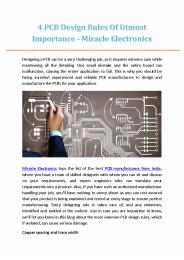Fiducial Markers – What They Mean For A PCB - Miracle Electronics - PowerPoint PPT Presentation
Title:
Fiducial Markers – What They Mean For A PCB - Miracle Electronics
Description:
When you want a PCB assembly from India, it is wise to approach a professional who knows how and when to use fiducial markers effectively to ensure a seamless assembly and production, without wasting time or money. – PowerPoint PPT presentation
Number of Views:28
Title: Fiducial Markers – What They Mean For A PCB - Miracle Electronics
1
Fiducial Markers What They Mean For A PCB -
Miracle Electronics
With PCBs being vital components of almost every
electronic and electrical device today, it is
important to take care of every detailing when
designing a PCB. One way to get PCB designing
right is by adding reference points to the
design, which helps to keep the orientation
right. Fiducial markers can help to provide such
reference points for imaging systems.
What are fiducial markers? The term fiducial
means a fixed-point basis of reference its
purpose being to compare. Fiducial markers are
surface marks that designers use as directional
measures in indexing systems. These markers work
as alignment marks in indexing systems of
electronic assembly industries that use
automation, helping to orient the PCBs in the
right skews and directions. They allow the
vision system to insert components precisely on
the circuits. Fiducial PCB markers thus prove to
be a vital aspect of the entire automated
process. These fiducial markers consist of three
parts a solid copper ring on the top or bottom
of the copper layer, the
2
circle in the solder mark which is the target
that needs to be aligned, and the option text
label on the side. The three benchmarks of a
fiducial PCB First datum The first datum,
depicted by X and Y directions, helps mounting
machines to recognize the PCB location. Second
fiducial benchmark This second benchmark helps
the mounting machine to recognize the PCB
orientation, and reveals the PCBs skew in the
clamps. Fiducial markers ensure that the PCB is
fixed in place, because even a slight rotation of
the PCB can result in complete damage of the
entire assembly. The machine can measure the
angle of the boards rotation to even the
nearest 0.01 degrees, and then compensates all
the placements accordingly. Third fiducial
benchmark This third benchmark assists the
mounting machine to compensate for shrinks and
stretches present in the PCB. Importance of
fiducial PCBs Precision is absolutely vital,
especially in processes that use automation.
Hence, machines need to know the boards exact
location and where to put the components.
Fiducial markers not only make this task easy,
but also ensure that the orientation of the
board is in the right direction and alignment.
Assembly machines can locate the precise
location of the board by using high-tech
cameras. The entire process thus needs not one,
but several fiducial marks in an irreversible
pattern.
3
When to use fiducial markers? Fiducial markers
are highly crucial in high-volume PCB assemblies
to ensure correct parts placement and
registration. Low-volume assemblies dont
necessarily require these marks, but it is good
if you use them in such situations too. However,
if you are placing your parts manually, then
such fiducial markers are not required at
all. When designing fiducial markers There are
four factors you need to consider when designing
fiducial markers. Shape It is best to stick to
circular marks because this shape is recognized
universally by every machine. Other shapes like
squares, diamonds, and hourglasses may or may not
be recognized by a machine. Size The basic
size of fiducial pads ranges between 1 and 3 mm,
but you could experiment out of the range too.
However, the basic range makes it easy for the
camera and equipment to recognize places as
fiducial markers. Material The fiducial pad
should be of the same material as the rest of
the PCB board, ensuring that the place is free of
solder mask or silkscreen that might cover the
markers. Clearance There should be appropriate
clearance around the pad, because the open space
around the PCB makes it easy for the camera to
pick up the fiducial markers without
interference. In
4
- addition, the diameter of the clearance should be
at least twice the size of the pad. - While using fiducial markers
- When you plan on using fiducial markers for your
PCB assemblies, it is important that you follow
certain essential guidelines. - The optimal size of fiducial markers ranges
between 1 and 3 mm. You need to maintain a
clearance area similar to the markers diameter. - The fiducial marker must maintain a distance of
0.3 inches from the boards edge, the distance
excluding the fiducial - markers clearance area.
- You need to maintain a circular shape when
placing the non- drilled copper layer, keeping
fiducial markers free from solder - mask.
- With PCB assembling being so critical, using the
fiducial markers the right way can help you have
a seamless assembly line, as compared to when
you have to make continuous adjustments. It is
thus wise to leave the task to experts, one like
Miracle Electronics, the best PCB assembly manufa
cturer (https//www.miracle.net.in/blog/8-recomme
nded- tips-find-best-pcb-assembly-manufacturer/),
who can correctly incorporate fiducials in the
PCB design, along with taking care of every
other designing and production aspect of a PCB
assembly from India. - For more Information https//www.miracle.net.in/































